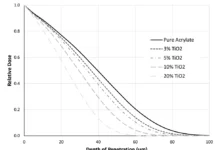By Stephen C. Lapin, Ph.D., BroadBeam Applications Specialist, PCT Engineered Systems, division of Ebeam Technologies, Comet Group

Answer: Electron beam (EB) technology has become well established in several web package printing applications. The type of EB equipment used in these applications is known as low energy system, which the industry defines as systems operating with electron acceleration potentials between 70 and 300 kV. The electrons are generated by an electrically operated filament within a vacuum chamber and then are accelerated though a thin foil window, where they impinge on a substrate at atmospheric pressure. Low energy EB systems are completely self-shielded and are available to handle webs from 400 mm to over 2.7 meters wide.
The penetration of electron beams into the substrate is controlled by the accelerating voltage of the beam. At the lower end of the spectrum (70 to 110 kV), energy can be concentrated in the first 5 to 20 microns, which is ideal for curing inks and coatings used in printing processes. EB energy causes a controlled ionization of materials that leads to the generation of free radicals. These radicals initiate the polymerization of acrylate functional monomers and oligomers without the need for added photoinitiators. This polymerization results in the instant drying (curing) of ink and coating layers. The absence of photoinitiators and the consistent cure process make EB attractive for printing on packaging for food, pharmaceutical or personal care products.
EB ink curing is commonly used for web offset package printing. Offset printing is attractive because of the low printing plate costs and lithographic quality images. The paste inks used for web offset printing are well suited for wet trapping of each color followed by curing with a single EB system at the end of the press. The most well established application for EB web offset printing is folding cartons – including milk, juice and ice cream cartons – printed on polyethylene (PE) coated paper board. Press equipment includes inline scoring and diecutting of the cartons so that finished carton blanks are delivered and stacked at the end of the press. The EB ensures consistent high speed curing of the low migration ink and coatings. Other applications for EB web offset package printing include dry food packets, labels and multi-wall bags. EB is a nice fit for shrink-sleeve label printing, since the very low heat EB curing process prevents distortion of the heat-sensitive shrink films. Modern variable sleeve web offset press equipment enables a relatively quick change of the print repeat length. This makes EB web offset printing technology potentially attractive in flexible packaging applications; however, this remains a niche with only a few installations. A challenge of web offset printing is the application of opaque white last-down or first-down ink layers, which often are needed when printing on clear films. In some cases, conventional water-based or solvent-based white inks are applied after EB curing to provide an opaque backup white layer.
EB ink systems also have been developed for flexographic printing. Flexo inks are traditionally liquid ink systems that require some degree of drying (dry-trapping) after the application of each ink layer. Interstation EB drying is not practical because of the size and cost of the equipment. The new ink technologies are optimized so that individual colors may be wet-trapped without interstation dryers. WetFlex™ ink technology, developed by Sun Chemical, is reported to contain limited amounts of water, which provides just enough of a viscosity change to allow wet-trapping. GelFlex® (Technosolutions) has adopted a similar approach using limited amounts of solvent. Both inks utilize central impression (CI) press configurations since they will not be dry enough until after EB to turn up against an idler roll. Both also offer very high print quality due to low dot gain enabled by the high solids content of the inks. Some specialized ink handling – including temperature control – is important with these inks. Uteco is one press manufacturer offering ink handling systems optimized for EB flexo printing.
There are several established packaging applications where EB-cured clear coatings are used to protect conventional printed ink layers. Notable examples include EB release coatings used for cold seal packaging and outdoor resistant EB coatings for films bags used to package lawn and garden products.
While these are examples of established EB web printing technologies, new applications for EB are on the horizon, which include digital printing and narrow web systems using compact sealed tube “EB lamps.”
Stephen C. Lapin, Ph.D., is a BroadBeam Applications Specialist for PCT Engineered Systems, a division of Ebeam Technologies, Comet Group. Do you have a question that you’d like to see addressed in this column? Submit your idea for consideration to sclapin@teampct.com.






